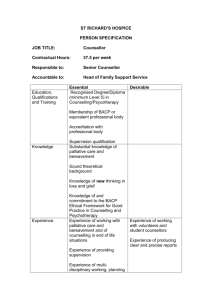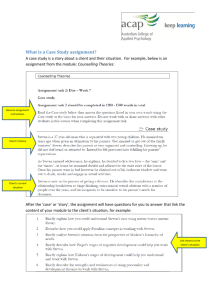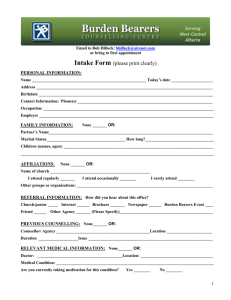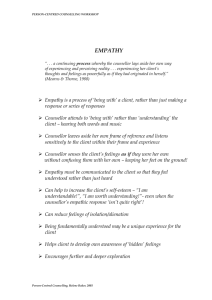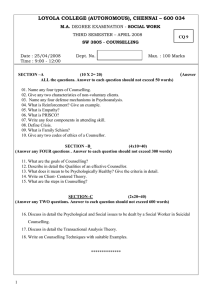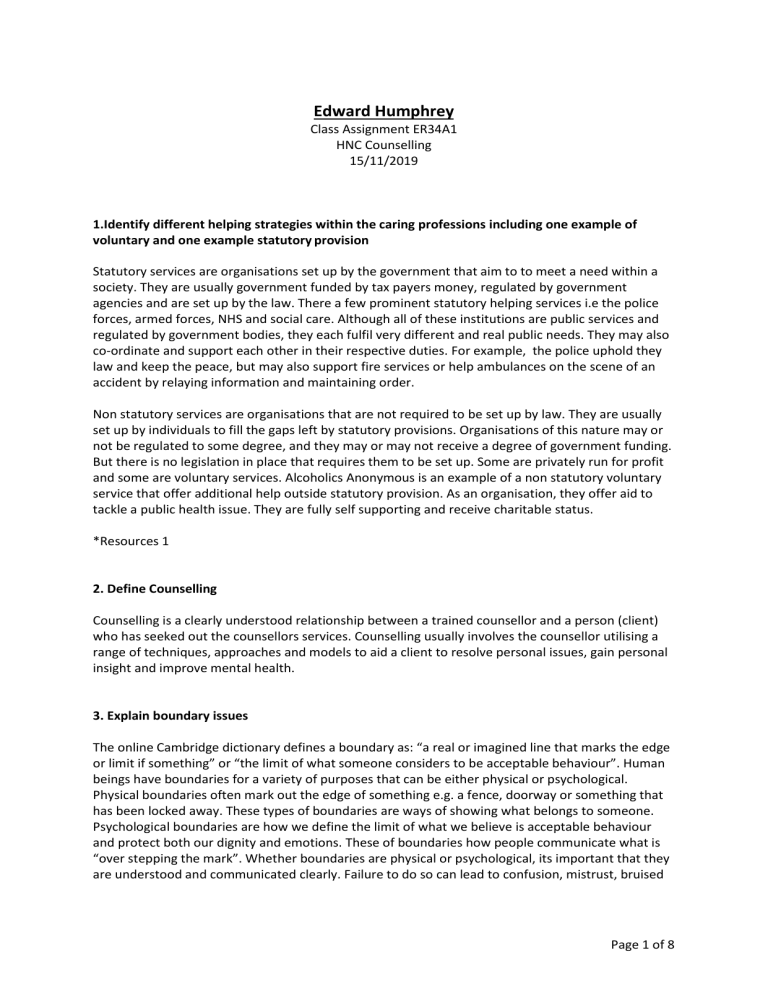
Edward Humphrey Class Assignment ER34A1 HNC Counselling 15/11/2019 1.Identify different helping strategies within the caring professions including one example of voluntary and one example statutory provision Statutory services are organisations set up by the government that aim to to meet a need within a society. They are usually government funded by tax payers money, regulated by government agencies and are set up by the law. There a few prominent statutory helping services i.e the police forces, armed forces, NHS and social care. Although all of these institutions are public services and regulated by government bodies, they each fulfil very different and real public needs. They may also co-ordinate and support each other in their respective duties. For example, the police uphold they law and keep the peace, but may also support fire services or help ambulances on the scene of an accident by relaying information and maintaining order. Non statutory services are organisations that are not required to be set up by law. They are usually set up by individuals to fill the gaps left by statutory provisions. Organisations of this nature may or not be regulated to some degree, and they may or may not receive a degree of government funding. But there is no legislation in place that requires them to be set up. Some are privately run for profit and some are voluntary services. Alcoholics Anonymous is an example of a non statutory voluntary service that offer additional help outside statutory provision. As an organisation, they offer aid to tackle a public health issue. They are fully self supporting and receive charitable status. *Resources 1 2. Define Counselling Counselling is a clearly understood relationship between a trained counsellor and a person (client) who has seeked out the counsellors services. Counselling usually involves the counsellor utilising a range of techniques, approaches and models to aid a client to resolve personal issues, gain personal insight and improve mental health. 3. Explain boundary issues The online Cambridge dictionary defines a boundary as: “a real or imagined line that marks the edge or limit if something” or “the limit of what someone considers to be acceptable behaviour”. Human beings have boundaries for a variety of purposes that can be either physical or psychological. Physical boundaries often mark out the edge of something e.g. a fence, doorway or something that has been locked away. These types of boundaries are ways of showing what belongs to someone. Psychological boundaries are how we define the limit of what we believe is acceptable behaviour and protect both our dignity and emotions. These of boundaries how people communicate what is “over stepping the mark”. Whether boundaries are physical or psychological, its important that they are understood and communicated clearly. Failure to do so can lead to confusion, mistrust, bruised Page 1 of 8 emotions, damaged relations and even finance harms, whether it be in professional or personal relations. Counsellors are bound by ethical standards to act in the best interest of their client. One step toward achieving this is for the counsellor to to create a safe and trustworthy space for the client to explore their issues. Boundaries are how this is achieved. They are the dos and don’t’s for both the client and counsellor. A client is more likely to feel comfortable in an environment that is clear, stable, predictable and reliably consistent. Counsellors also have to establish clear boundaries to protect themselves from themselves. It is a sad fact of human nature that it is within us all to abuse positions of power. Understanding where the counselling relationship begins and ends keeps the relationship within profession bounds. When a counsellor falls short of these standards, not only is he liable to enter the danger zone of letting his client down but could also end up with a professional malpractice case. One google search can reveal a plethora of malpractice cases brought against therapists who didn’t take boundary issues seriously. *Resources 3 4. Explain the importance of equality of opportunity in the counselling relationship The Importance of equality of opportunity in the counselling relationship has at its core nondiscriminatory attitudes and practices. It is a way of understanding that each individual should be given an equal and fair opportunity at counselling services. All human beings have preferences, sympathies and biases. But when looked at through the lens of ethical standards it becomes clear how important it is to set aside personal biases when acting in a profession capacity. Having respect for another persons human rights, dignity, variety of human experience and culture, are all values specifically stated in BACPs ethical framework. As counsellors, acting in the best interest of their clients, religious leanings, political views, gender, race, disability etc should interfere with of offering a fair and adequate service. *Resources 4 5. Explain the importance of theory underpinning competence One way to understand a theory is as “a set of principles on which the practice of an activity is based”. A theory is an abstraction, a generalisation, an idea or set of ideas grouped together. This becomes something of use once it has been subjected to the rigours of thorough testing, observation and experimentation. Carl Rogers explains that it was this process of scrupulously trolling over recordings of counselling sessions with clients that he developed and refined the concepts fundamental to person centred therapy. With regards to counselling and understanding the importance of theory underpinning competency, we see it is the conceptual framework which guides and informs the therapeutic approach. Because a good theory has been empirically tested, it removes much guesswork and opinion. It allows the counsellor to tap into a broad range of information which to base strategies. Whats more, a well used theory will produce results in practice. We can really feel this in the Kurt Lewin quote “nothing is so practical and as good theory”. Carl Rogers demonstrates the truth of this in the Gloria tapes, Page 2 of 8 where he applies his person centred therapy approach and we see what he describes as “therapeutic movement” in his female client. For the counsellor, because counselling is a dynamic process, it is crucial to understand multiple theories that can be used in different instances during therapeutic process. *Resources 5 6. Describe the core conditions according to Rogers Carl Rogers describes the core conditions of person centred therapy as “ways of being”. He often describes the conditions as orientations and attitudes of the counsellor. Congruence Congruence is the quality of being self accepting and authentic, our inner experience is reflected in our outer expression. Rogers puts it ‘that the therapist should be, within the confines of this relationship, a congruent, genuine, integrated person”. In this, Rogers isn’t suggesting that the counsellor should be the finished article in every aspect of life. It is enough that the counsellor just be completely themselves during the time spent with the client - they don’t have to have the persona of the perfectly polished professional. A more relaxed and honest attitude energy can have the effect of helping clients relax and motivate them towards honesty. If we are experiencing feelings, we don’t deny them to ourselves. It is believed that when the counsellor is being consistently and reliably real, they become someone to be trusted. Empathy Empathy in this context is understood to be an “Accurate empathic understanding of the clients experience of himself”. This state is not to be confused it’s over identification with another persons emotion states or a purely detached non judgement. It’s is maybe better understood as something in the middle of those two extremes. Its means to understand another persons experience with them and to ‘feel with another’s psyche”(Carl Jung), but always maintaining the “as if” quality. This condition is well described by Carl Jung’s “unprejudiced objectivity”, which he qualifies as “it is a human quality, a kind of deep respect for the facts, for the man who suffers from them, and the riddle of such a mans life”. When this experience is achieved, the counsellor is able to reflect back to the client many thoughts, feelings and states, sometimes not understood by the person themselves. The client feels understood and encouraged, and should start to be more reflective of themselves. Unconditional positive regard Unconditional positive regard, just as it sounds, is a complete acceptance of a person just as they are. Using both “behaviours and words” its is the job of the counsellor reflect that the person sitting before them is cared for and not judged. When this condition is met, it facilitates an atmosphere where the client can open up and speak freely without feeling condemned. Resource 6 Page 3 of 8 7. Outline the counselling process and identify the skills involved The counselling process we are focusing on here is the Egan three stage model. It is important to note that the stages being outlined are not static. They are instead better described as fluid, dynamic and cyclical. Meaning the client will move between these stages, sometimes back and forward. But the larger goal is ultimately to be moving toward stage three action and implementation. Stage 1 Exploration This stage is about exploring what is going on with the client and building a trusting relationship. We want to know what brought the client here. Encouraging the client to open up and speak in a way that a clear understanding of the clients story and problems can emerge. Eventually narrowing the focus of what matters. The skills expected from the counsellor at this stage include: listening, probing, focusing, reflecting and summarising. Stage 2 Insight This stage is about insight and understanding. We build on what we have learned in stage one. What does the client want. But now we want more depth, exploring new possibilities and reframing. Aligning realistic and achievable goals with values. The skills required at this stage include: prompting, challenging, reflecting, summarising and advanced empathy. Stage 3 Acting This stage is about assisting the client to take action. It includes encouraging and supporting. The counsellor will be helping the client bring together everything that was revealed in stages one and two, refine goals, look a resources and develop strategies act on. The skills involved at this stage include: reflecting, challenging, prompting and summarising. *Resources 7 8. Explain Theoretical concepts fundamental to each stage of the Egan model Stage 1 At this stage we trying unveil what is going on with the client, get them speaking and establish trust. Therefore in stage 1a (what is going on), we would be employing person centred therapy and applying SOLAR skills ( sit squarely, open questioning, leaning in, eye contact and relaxed) to make the client as comfortable and at ease as possible. As we move on to stage 1b, wanting to get a little deeper and uncover blind spots, we would applying the same theories as stage 1a but also bringing in psychodynamics to uncover what might not have been previously acknowledged. Stage 2 As we move into stage 2a & 2b, we going to be pressing the client and challenging existing views and generating options and possible smart goals ( specific, measurable, achievable, realistic and time measured) Then on through stage 2c to check how well what has discussed lines up with the clients values. As this stage it would involve a lot self reflection, examination, questioning and looking at alternatives. The theoretical approach that could best fit with the setting of goals and in challenging behaviours, could be cognitive behaviour therapy(CBT). Page 4 of 8 Stage 3 Now being at stage 3, everything from stages 1 and 2 will be brought forward. In stage 3a and 3b we are looking the possible paths, picking the right ones and building strategies based on available resources. Stage 3c will involve definite plans, being specific and realistic about what is going to be achieved and when. As all this will involve new ways of acting and doing things (reconditioning), behaviourism would would be the best alternative. Page 5 of 8 Resources Class notes (Teams) were referred to on all questions. Question 1 https://studymoose.com/statutory-and-non-statutory-public-services-essay https://www.gov.uk/government/organisations Question 3 https://www.thesun.co.uk/news/5181542/family-ordered-to-hand-their-600000-home-toneighbours-in-fence-row-reveal-they-have-no-idea-what-will-happen-to-them/ https://www.simplypsychology.org/Erik-Erikson.html https://dictionary.cambridge.org/dictionary/english/boundary Question 4 https://www.equalityhumanrights.com/en/secondary-education-resources/usefulinformation/understanding-equality https://www.bacp.co.uk/events-and-resources/ethics-and-standards/ethical-framework-for-thecounselling-professions/ https://www.nationalcounsellingsociety.org/about-us/equal-opportunities/ Question 5 Client Centred therapy (chapter 1) Carl Rogers. https://m.youtube.com/watch?v=24d-FEptYj8 https://m.youtube.com/watch?v=3g2iRmjQsPI Question 6 Book - Client Centred Therapy (Carl Rogers) https://counsellingtutor.com/counselling-approaches/person-centred-approach-to-counselling/carlrogers-core-conditions/ https://app.shoreline.edu/dchris/psych236/Documents/Rogers.pdf https://trueselfcounseling.com/2016/02/20/3-core-conditions-for-therapeutic-change/ Page 6 of 8 Question 7 http://highgatecounselling.org.uk/members/certificate/CT1W3%20Paper%202.pdf Page 7 of 8 . Page 8 of 8
